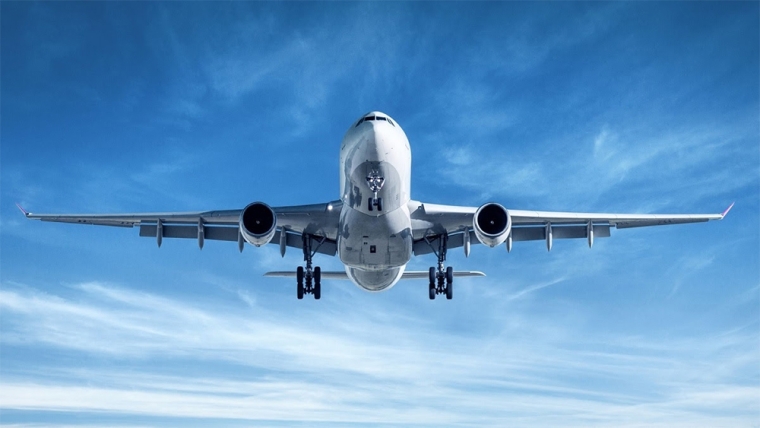A combination of increased demand and technological improvements has driven the change in aviation emissions over the last half-century. Total CO2 emissions are often explained through the “Kaya identity” — how many people there are, their income, the energy efficiency of economies, and the carbon intensity of energy. We can use a similar framework to understand the drivers of aviation emissions.
In this article, I look at historical changes in aviation demand, efficiency, and its contribution to climate change. Most of this work is based on an excellent paper by Candelaria Bergero and colleagues and another by David Lee and colleagues. Bergero’s paper also looks at future trajectories of aviation demand and emissions; if you’re interested, it’s worth digging into more detail.
Efficiency has improved, but increasing global demand has led to higher emissions
To calculate carbon emissions from aviation, we need to know three metrics:
- Aviation demand: How many passenger and freight kilometers;
- Energy efficiency: How much energy is used per kilometer;
- Carbon intensity: What fuel is being used, which tells us the carbon emitted per unit of energy.
Multiply these metrics together, and we get carbon dioxide (CO2) emissions.
In the chart below, I’ve shown trends in these relevant metrics since 1990. These come from the paper by Candelaria Bergero and colleagues, published in Nature Sustainability.2
You’ll see that there is a blip in 2020 and 2021. That’s the sudden drop in international and domestic transport during the COVID-19 pandemic. Demand is rebounding quickly, and is expected to reach pre-pandemic levels again this year. For now, let’s ignore the unique period of the pandemic and focus on the trends up to 2019.
Between 1990 and 2019, both passenger and freight demand has approximately quadrupled. More people are flying, and more stuff is being moved around. In 2019, passengers traveled more than 8 trillion kilometers: that’s about the same as a light year.3
At the same time, flying has become more than twice as energy efficient. Traveling one passenger-kilometer in 1990 used 2.9 megajoules (MJ) of energy. By 2019, this had more than halved to 1.3 MJ. This efficiency has come from improved design and technology, larger planes that can carry more passengers, and a higher ‘passenger load factor’. Empty seats are less common than in the past.
The carbon intensity of that fuel — how much CO2 is emitted per unit — has not changed at all. We used standard jet fuel in 1990 and are using the same stuff today. It has not gotten any cleaner. Biofuels and other alternatives are just a tiny fraction of global demand.
If flying has become more than twice as energy efficient, and the carbon emitted per unit of energy has not changed, then it follows that the carbon efficiency of traveling one kilometer is also more than twice as high. In 1990, one passenger-kilometer would emit 357 grams of CO2. By 2019, this had more than halved to 157 grams.
How have the changes in demand and technology affected CO2 emissions?
Well, if demand has quadrupled, but aviation has become twice as efficient, then emissions will double. The gains in efficiency have partly counteracted the emissions from increased demand.
In 1990, global aviation emitted around 0.5 billion tonnes. In 2019, that was around 1 billion.
Global CO2 emissions from aviation have quadrupled since the 1960s
I was curious to see a longer-term perspective. To achieve this I extended the recent data back to 1940, using data from a paper by David Lee and colleagues.4 This is shown in the chart below. Emissions have quadrupled since the mid-1960s.
Aviation accounts for 2.5% of global CO2 emissions
I’ve calculated aviation’s share of global emissions using the time series above and total CO2 emissions data from the Global Carbon Project.5
You can see the results in the chart below. In 2019, aviation accounted for 2.5% of CO2 emissions from fossil sources and land use. This share has fluctuated from 2% to 2.5% since the mid-1990s but with a marked increase since 2010.

Non-CO2 climate impacts mean aviation accounts for around 4% of global warming to date
While aviation accounts for around 2.5% of global CO2 emissions, its overall contribution to climate change is higher.
Along with emitting CO2 from burning fuel, planes also affect the concentration of other atmospheric gases and pollutants. They generate a short-term increase but a long-term decrease in ozone and methane, and increased emissions of water vapor, soot, sulfur aerosols, and water contrails. While some of these impacts result in warming, others induce a cooling effect. But overall, the warming effect is stronger.
David Lee et al. (2020) quantified the overall effect of aviation on global warming when all of these impacts were included. To do this, they calculated the so-called “radiative forcing”. Radiative forcing measures the difference between incoming energy and the energy radiated back to space. If more energy is absorbed than radiated, the atmosphere becomes warmer.
Taking all of these effects into account, the authors estimate that aviation has accounted for approximately 3.5% of effective radiative forcing to date. Another study estimates that it has been responsible for 4% of global temperature rise since pre-industrial times.6
Although CO2 gets most of the attention, it accounts for less than half of this warming. Two-thirds come from non-CO2 forcings. Contrails — water vapour from aircraft exhausts — account for the largest share. This explains why aviation contributes 2.5% of annual CO2 emissions but more when it comes to its total impact on warming.
Aviation’s share of global emissions is likely to rise as other sectors decarbonise faster
Aviation is one of the hardest sectors to decarbonise. Electricity can become low-carbon through the deployment of renewables and nuclear; road transport and heating through electrification. Even “hard-to-abate” industries such as cement and steel have emerging low-carbon alternatives.7
Aviation is, by comparison, behind the curve. Global demand will likely grow in the coming decades as populations get richer. Therefore, the rise in emissions will be determined by whether aviation can maintain improvements in energy efficiency and switch to low-carbon fuels. So far, the sector has made almost no progress on the latter.
While more efficient planes can dampen some of the growth in emissions, they can’t eliminate them completely. To do that, the industry will need to move from jet fuel to electrification, biofuels, hydrogen, or a combination. Until it makes this switch, aviation will make up an ever-increasing share of global emissions.
Acknowledgements
Many thanks to Max Roser, Edouard Mathieu and Candelaria Bergero for their valuable feedback and comments on this article.
Endnotes
-
Gössling, S., & Humpe, A. (2020). The global scale, distribution and growth of aviation: Implications for climate change. Global Environmental Change, 65, 102194.
-
Bergero, C., Gosnell, G., Gielen, D., Kang, S., Bazilian, M., & Davis, S. J. (2023). Pathways to net-zero emissions from aviation. Nature Sustainability, 6(4), 404-414.
-
8 trillion kilometers is equivalent to 0.85 light-years.
-
Pre-1990 data comes from David Lee et al. (2021). Data from 1990 onwards comes from Bergero et al. (2023), as above.
Lee, D. S., Fahey, D. W., Skowron, A., Allen, M. R., Burkhardt, U., Chen, Q., ... & Wilcox, L. J. (2021). The contribution of global aviation to anthropogenic climate forcing from 2000 to 2018. Atmospheric Environment.
-
Andrew, R. M., & Peters, G. P. (2023). The Global Carbon Project's fossil CO2 emissions dataset (2023v36) [Data set]. Zenodo. https://doi.org/10.5281/zenodo.10177738
The data files of the Global Carbon Budget can be found at: https://globalcarbonbudget.org/carbonbudget/
-
Klöwer, M., Allen, M. R., Lee, D. S., Proud, S. R., Gallagher, L., & Skowron, A. (2021). Quantifying aviation’s contribution to global warming. Environmental Research Letters.
-
Griffiths, S., Sovacool, B. K., Del Rio, D. D. F., Foley, A. M., Bazilian, M. D., Kim, J., & Uratani, J. M. (2023). Decarbonizing the cement and concrete industry: A systematic review of socio-technical systems, technological innovations, and policy options. Renewable and Sustainable Energy Reviews.


We welcome your comments below. If you are not already registered, please register to comment
Remember we welcome robust, respectful and insightful debate. We don't welcome abusive or defamatory comments and will de-register those repeatedly making such comments. Our current comment policy is here.